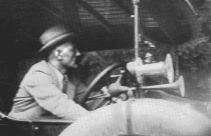
Gurdjieff International Review
Editorial Introduction
In Memoriam: An Introduction to Gurdjieff
Mister Gurdjieff died in Paris on October 29, 1949. Our ninth issue, the last of this millennium, commemorates the 50th anniversary of his death. This provides a special occasion to consider the rich multi-faceted portrait of Gurdjieff that has emerged and that the future will inherit.
In producing this web site and printed journal over the past few years, we have received numerous queries about Gurdjieff from readers of many ages and backgrounds, particularly from younger readers who are often more familiar with computers and the internet than are their elders. Also as parents, who’s children are now adult, we have been asked by them about our life-long interest in Gurdjieff, about who he was, and what he taught. Therefore the subject matter for this issue has converged upon this theme.
George Ivanovitch Gurdjieff was an extraordinary man, a master in the truest sense. His teachings speak to our most essential questions: Who am I? Why am I here? What is the purpose of life, and of human life in particular? As a young man, Gurdjieff relentlessly pursued these questions and became convinced that practical answers lay within ancient traditions. Through many years of searching and practice he discovered answers and then set about putting what he had learned into a form understandable to the Western world. Gurdjieff maintained that, owing to the abnormal conditions of modern life, we no longer function in a harmonious way. He taught that in order to become harmonious, we must develop new faculties—or actualize latent potentialities—through “work on oneself.” He presented his teachings and ideas in three forms: writings, music, and movements which correspond to our intellect, emotions, and physical body.
Michel de Salzmann remembers that, “During his lifetime, Gurdjieff was almost unknown outside his circle of followers. From the 1950s onward, however, his ideas began to spread both through the publication of his own writings and through the testimonies of his pupils.” We include an introduction to, and a selection of excerpts from, Mr. Gurdjieff’s writings and talks.
Of Gurdjieff, Henriette Lannes asked, “What did he represent? Who was he? What did this being, this force, signify?” Her testimony, along with those of others of his pupils, provides a glimpse of possible answers. “But it was not so much what he said or what he did that impressed as what he was,” Dr. Kenneth Walker concluded, “Gurdjieff was a living example of the outcome of his own teaching, which he summed up in the words ‘the harmonious development of man.’”
So here’s to all those who have what Gurdjieff described as “enquiring minds, which long for the truth of the heart, seek it, strive to solve the problems set by life, try to penetrate to the essence of things and phenomena and to penetrate into themselves.”
We dedicate our work on this issue to our children: Benjamin, Gareth, Jessica, & Lisa.
Greg & June Loy
Walter Driscoll
|
This webpage © 1999 Gurdjieff Electronic Publishing Featured: Fall 1999 Issue, Vol. III (1) Revision: October 1, 1999 |